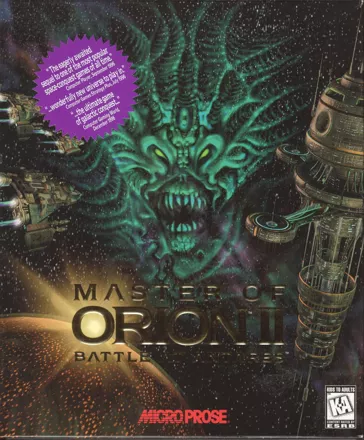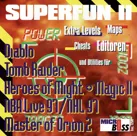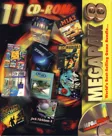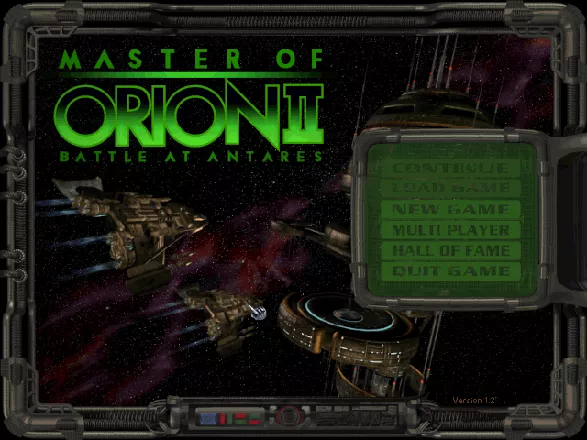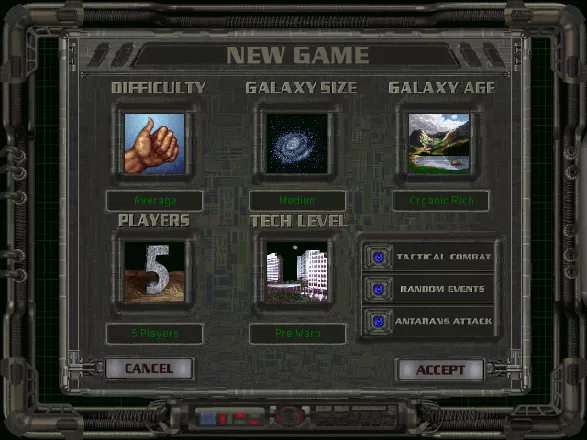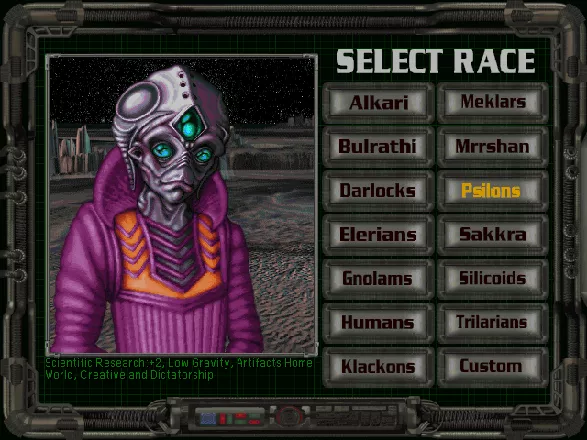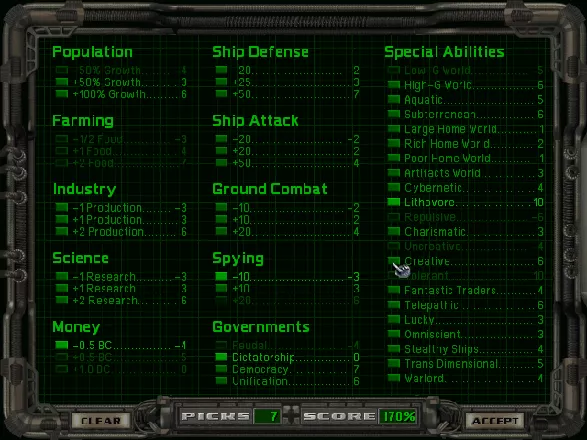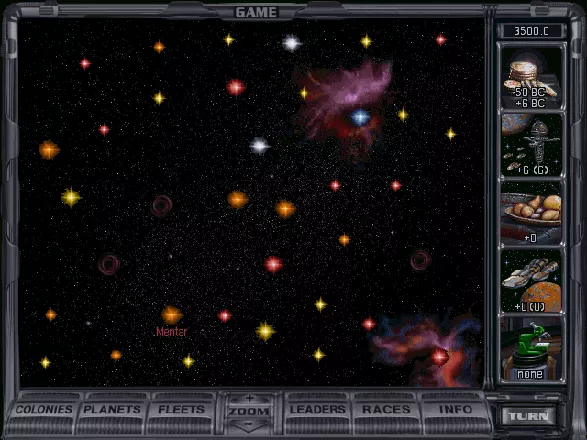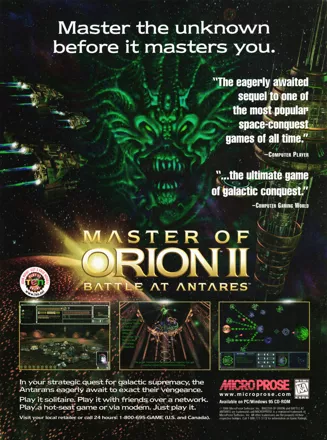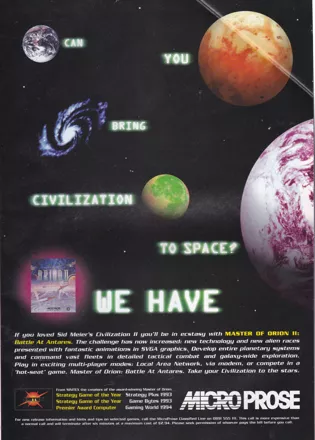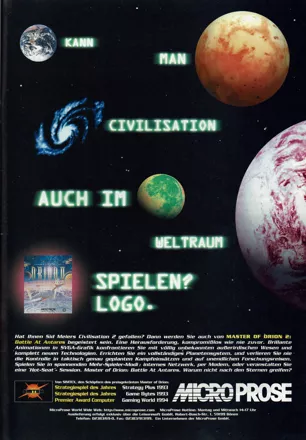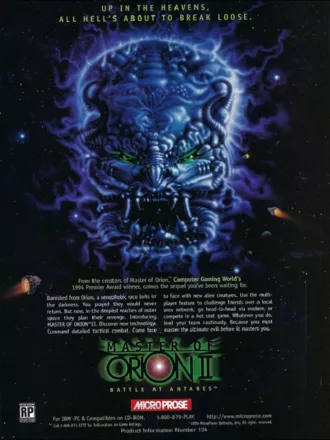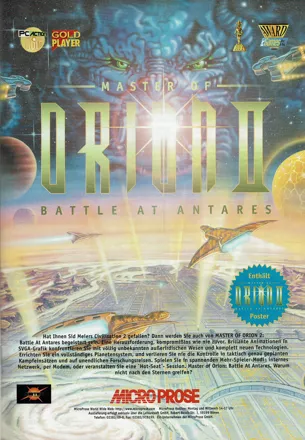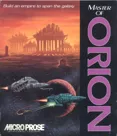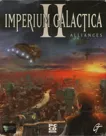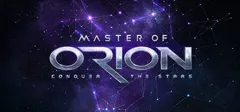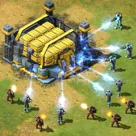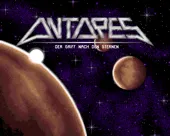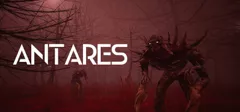Master of Orion II: Battle at Antares
Description official descriptions
Legends speak somewhere in space of the mystical planet Orion. Created by the Ancients, it remains unclaimed due to a powerful Guardian that orbits the planet and keeps out intruders. These same Ancients long ago fought a war against the Antarans and banished them into another dimension. Now... long after the Ancients empire has vanished, new races take to the stars, wishing to establish their own star empires, defeat the Antarans and become... The Master of Orion.
Master of Orion II: Battle At Antares is a turn-based 4x space empire game and is the sequel to Master of Orion, reinterpreting that game from scratch. Unlike the original the game can be played single player or with other human players. The player takes the role of a ruler of one of thirteen races, while also having the extra option of creating a custom one. They must manage planet resources to build ships and facilities, improving production. Exploration of the galaxy is done via scouts and colony ships, which can establish new planets as part of the empire. Research must also be done to discover and utilize new technologies. Alien civilizations which are encountered can be negotiated with, or ships can engage in combat in a turn-based grid system. As new systems are explored, random events are triggered and strange artifacts found in orbit around unexplored planets. Wormholes can also be found which allow transport across dozens of parsecs into new star systems.
The game can be won in different ways: through conquest of all other races, being voted supreme leader of the galaxy or destruction of the Antaran race.
Spellings
- 银河霸主II:安特雷斯之战 - Simplified Chinese spelling
Groups +
Screenshots
Promos
Videos
See any errors or missing info for this game?
You can submit a correction, contribute trivia, add to a game group, add a related site or alternate title.
Credits (DOS version)
51 People (48 developers, 3 thanks) · View all
| Design | |
| Lead Programming | |
| Programming | |
| Libraries / Utilities | |
| Graphics / Artwork | |
| Additional Graphics / Artwork | |
| Music | |
| Sound | |
| Documentation | |
| [ full credits ] | |
Reviews
Critics
Average score: 81% (based on 23 ratings)
Players
Average score: 3.9 out of 5 (based on 209 ratings with 15 reviews)
Best turn-based galaxy-conquest game to date
The Good
High praise? Well deserved I would say. Master of Orion II is still on the top spot of my (very short) list of games with any real(!!) replay value.
The user interface is comfortable, graphics and sound add nicely to the overall mood, but what it really sets in front is the gameplay and the nearly infinite amount of tactics you can (must) use to win a game.
Winning with the Psilons is a piece of cake? Switch to an uncreative race and get yourself slaugthered the next few times. Can you adopt? How can the computer (great AI) grow that fast with the same race?
You will always find settings where the game is a real challenge.
The Bad
Towards the end (espacially if you are playing for a good score), the micro-management gets a bit tedious and if you finished it in one session you might feel a bit drowsy.
The Bottom Line
Turn-based space-exploration and empire-building game (fortunately not) out there. You can get it on earth.
Windows · by Zzap (56) · 2000
If I could make love to one game, this would be it
The Good
Everything. The diplomacy was awesome..the researching was incredible...the micromanagement was not too tedious, and the whole fact that this is a strategy game at it's greatest makes this a must buy for anyone.
The Bad
The fighting and upgrading ships could use some work.
The Bottom Line
I strongly recommend that any fan of strategy games buy this. Ever wanted to be a Napoleon of space? Here is your chance.
Windows · by xTSx (13) · 2001
The Good
The music sometimes never leaves my head, its so catchy. The game play doesnt miss a beat. And the choices are many and diverse. This game has some of the hightest replayabilty that I have ever seen. Graphics are good and the game's progression of difficulity is terrific for new players. In the lowest level of difficulity the game is easy to learn and enjoy. It hooks the new players and dares them to try a real challenge. The game never really gets boring and it all comes together to form an excellent game worthy of the title Master of Orion. Truly one of the greatest games ever to come from Microprose.
The Bad
there are some small things that could have been done that would have made this game even better. (1) After you colonize or take over a colony you cant rename it. (note: I know that when you first land on a planet in a system you can name the system but after that you can change it.) (2) Although the music is catchy, there is a definate need for more music. Its catchy because there is only one song or theme playing through the whole game. (3) more options on diplomacy screen. ie.. using your spys to kill a leader or start a coup. Overall there really are no complaints with the game as far as I know.
The Bottom Line
Great game. If you like civ you will like this one.
Note: if you only play shooters and you are looking for a new game to try that isnt a cookie cutter shootem-up then try this one. Trust me Its worth it!
Windows · by William Shawn McDonie (1131) · 2001
Discussion
| Subject | By | Date |
|---|---|---|
| Compatibility - just use Steam | MerlynKing | May 8, 2022 |
| Has anyone witnessed the battle at Antares? | CalaisianMindthief (8171) | Oct 6, 2015 |
| Master of Orion II How to install in win7 | Dim Gri (30) | Oct 24, 2011 |
Trivia
Combat system
The whole tactical ship combat system has many similarities with the system used in Renegade Legion: Interceptor. This not is not only restricted to technical aspects. If one examines the ship graphics in Interceptor more closely, there should be a moment of déjà vu.
Development
The folks at SimTex were calling this game Master of Antares when it was in early development. Later the name was changed to Master of Orion 2 so the game would be more easily recognized by consumers as the sequel to the award-winning original.
References
- Loknar’s ship was christened as "Avenger", exactly the same as the ship required in X-COM: UFO Defense to travel to Cydonia.
- The Elerians race is similarly named to Elerium, the alien energy source from X-COM.
- Both Master of Orion games as well as the first X-COM game have an alien race named Silicoid, however the look of the creatures is very different between the two game series.
- The Antaran Star Fortress (when traveling to their homeworld via Dimensional Portal) is commanded by a Ship Captain. Their name is Xyphys, the Antaran Warrior, and has the following abilities: "Fighter Pilot* Helmsman* Ordnance* Security* Weaponry*" as noted in the moohero.lbx archive.
- Phasers, food replicators, transporters, federation type government, the human leader being bald, charismatic and democratic and a few of the ship designs may be references to Star Trek: The Next Generation.
Awards
- Origin Awards
- 1996 - Best Fantasy or Science Fiction Computer Game
Information also contributed by Chris Martin, Dum Gri, lilalurl, NGC 5194, PCGamer77, Technocrat and WildKard.
Analytics
Related Sites +
-
MOO2MOD
unofficial website with MOO2 fan patch (1.50) -
Master of Orion II Home Page
A Microprose Space resource management game. Lists race characteristics, improvements, technology and has a poll. -
Master of Orion II Online
Fansite with blog, DOSBox guide and a comprehensive mod list (English) -
MicroProse Games: Master of Orion II
official page of the game at the MicroProse website, archived copy from 1996 by the Wayback Machine -
The Orion Nebula Forum
Fan forum about multiplayer and the unofficial 1.4 patch (English)
Identifiers +
Contribute
Are you familiar with this game? Help document and preserve this entry in video game history! If your contribution is approved, you will earn points and be credited as a contributor.
Contributors to this Entry
Game added by Tomer Gabel.
Macintosh added by Terok Nor.
Additional contributors: PCGamer77, Kalirion, David Ledgard, CaesarZX, Patrick Bregger, Dim Gri, Plok, MrFlibble, J D.
Game added August 4, 1999. Last modified December 8, 2024.


